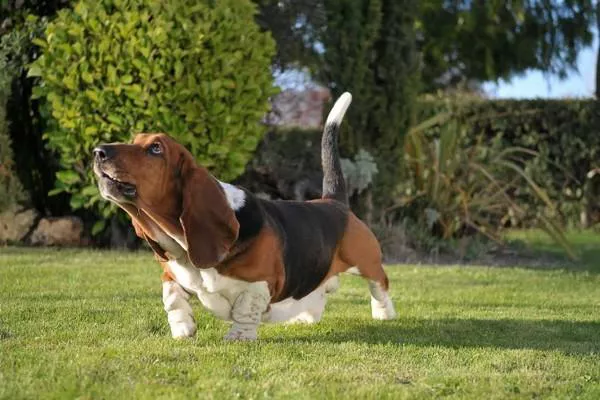Introduction
Basset Hounds are beloved for their unique appearance, friendly nature, and exceptional scent tracking abilities. While they may not be typically regarded as guard dogs, with the right training and socialization, they can develop protective instincts and become effective family protectors. This comprehensive guide will provide you with valuable insights and practical strategies to train your Basset Hound to protect your home and loved ones.
1. Understanding the Basset Hound Temperament
Before embarking on any training program, it is crucial to understand the inherent temperament and characteristics of the Basset Hound breed. Basset Hounds are generally known for their laid-back and easygoing nature. They are often described as gentle, friendly, and good-natured. However, they may exhibit territorial and protective behaviors when properly trained and socialized.
2. Start with Obedience Training
Building a solid foundation of obedience training is essential for any protection training. Begin by teaching your Basset Hound basic commands such as “sit,” “stay,” “down,” and “come.” Positive reinforcement techniques using treats and praise work best with this breed. Consistency, patience, and repetition are key to successful obedience training.
3. Socialization
Proper socialization is crucial for any dog breed, including Basset Hounds. Expose your Basset Hound to various environments, sounds, people, and animals from an early age. This exposure will help them become comfortable and confident in different situations, reducing the likelihood of fear-based aggression. Well-socialized Basset Hounds are more likely to make rational decisions when faced with potential threats.
4. Building Confidence
To train your Basset Hound to protect, you need to build their confidence. Engage in activities that encourage confidence-building, such as agility training, puzzle games, and scent tracking exercises. These activities not only provide mental stimulation but also help develop problem-solving skills and boost their self-assurance.
5. Establish Boundaries
Creating clear boundaries is essential for any protection training. Teach your Basset Hound where they are allowed and not allowed to go within your home and property. This includes designating areas where they should be alert and on guard. Reinforce these boundaries consistently, and ensure your Basset Hound understands the distinction between acceptable and unacceptable behavior.
6. Encourage Alertness
Basset Hounds are known for their acute sense of smell but may not be naturally inclined to be watchful or alert. Encourage and reward moments of natural alertness, such as when they perk up their ears or display heightened awareness of their surroundings. Pair these moments with positive reinforcement to associate vigilance with rewards.
7. Introduce Guarding Behaviors
Once your Basset Hound has mastered basic obedience and has developed a sense of alertness, you can begin introducing specific guarding behaviors. Start by teaching them to bark on command. Use a verbal cue such as “Speak” and reward them when they bark. Progressively increase the difficulty by introducing a specific target, such as a doorbell or a knock on the door, and reward them for barking in response.
8. Train a Reliable Recall
A reliable recall command is vital for the safety of your Basset Hound, especially when they are in protection mode. Train your dog to come to you immediately when called, regardless of distractions or stimuli. Start in a low-distraction environment and gradually increase the difficulty level. Always reward your Basset Hound with treats and praise when they respond promptly to the recall command.
9. Enroll in Professional Training
Consider enrolling your Basset Hound in professional protection training classes or working with a knowledgeable dog trainer experienced in guard dog training. These experts can provide guidance, structure, and expertise in training your Basset Hound to protect effectively and safely. They can also help you fine-tune your training techniques and address any challenges that may arise.
10. Maintain a Balanced Approach
It is essential to maintain a balanced approach when training your Basset Hound to protect. While it is important for them to be alert and protective, it is equally crucial to ensure they remain well-socialized and friendly. Strive for a balanced temperament that allows your Basset Hound to distinguish between real threats and everyday situations.
11. Legal Considerations
Before proceeding with protection training, it is essential to understand the legal implications and regulations in your area. Some regions have specific laws and restrictions regarding the training and ownership of guard dogs. Familiarize yourself with these regulations to ensure compliance and responsible ownership.
12. Continued Training and Reinforcement
Training is an ongoing process, and regular reinforcement is crucial to maintain the skills and behaviors you have taught your Basset Hound. Schedule regular training sessions to practice obedience commands, guarding behaviors, and recall. Additionally, provide mental stimulation through interactive toys, games, and continued socialization.
Conclusion
While Basset Hounds may not be the first breed that comes to mind when thinking about protection dogs, with the right training, socialization, and reinforcement, they can become reliable family protectors. Remember to approach the training process with patience, consistency, and positive reinforcement. A well-trained and properly socialized Basset Hound can offer both companionship and an extra layer of security for you and your loved ones.


